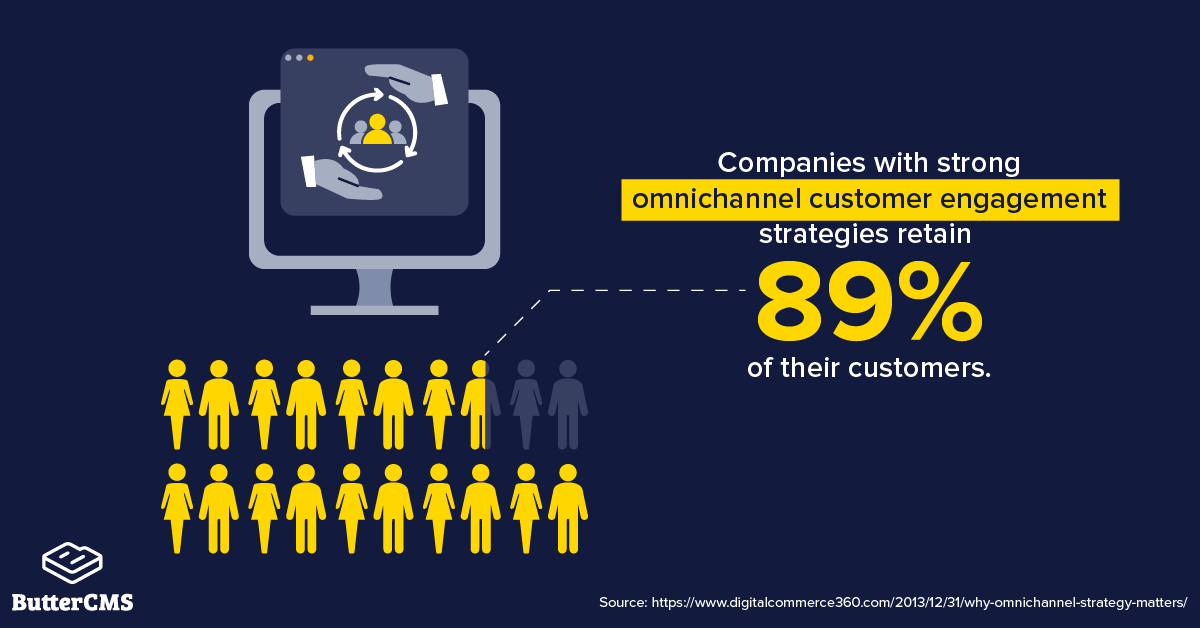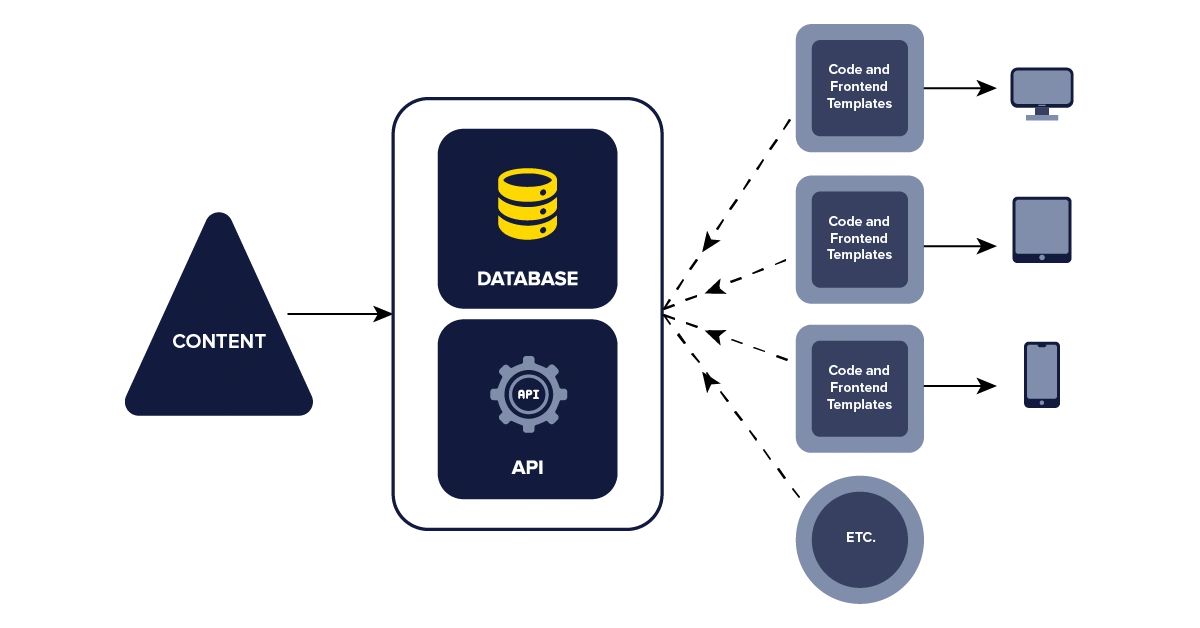Omnichannel content management is the strategic process of creating, managing, and delivering content across multiple channels and devices to deliver a unified customer experience.
In today's world, consumers interact with brands across multiple channels and devices. Some prefer browsing on their phones, others on their laptops, while some even use their smartwatches or TV screens to engage with content. This multichannel reality demands a new approach to content delivery.
To truly connect with customers and drive engagement, businesses must adopt an omnichannel content management strategy. It allows them to centrally manage and distribute content across several platforms, ensuring that consumers get a consistent experience regardless of the channel or device they are on.
In today’s piece, we will explore what omnichannel management entails, why it’s crucial for all modern businesses, and how you can go about implementing it.
What is omnichannel content management?
Omnichannel content management is a strategy in which businesses use a centralized content repository to deliver content across various channels and devices. The goal is to ensure that the users get consistent, personalized, and contextually relevant experiences across all touchpoints, including websites, mobile apps, conversational interfaces, and kiosks.
This approach simplifies content creation, accelerates time-to-market, and helps develop deeper customer connections through tailored experiences. The data confirms its effectiveness: Per Google's Consumer Insights, omnichannel strategies boost incremental store visits by 80%.
Key principles of omnichannel content management
The world of omnichannel content is governed by the following key principles:
-
Consistency: The same underlying message, tone, and branding are maintained across all platforms, allowing users to experience a cohesive brand identity.
-
Personalization: Content is tailored to individual users based on their preferences, behaviors, and the specific channel they are using.
-
Centralization: Content is managed from a single, centralized system, which makes it easier to handle various channels, reduce redundancies, and streamline workflows.
-
Integration: Standardized APIs are used to integrate the centralized content system with all the digital channels.
-
Ease of reuse: The same centralized content system and APIs can be reused to support newer channels and devices in the future.
Omnichannel content management vs. multichannel content management
The goal of omnichannel and multichannel content management is the same: engage customers across multiple platforms. However, their strategies and resulting user experiences differ and set them apart.
In a multichannel approach, each channel typically operates independently. This can result in inconsistent experiences, as the content and messaging may vary from one platform to another. Customers may find themselves encountering disjointed interactions as they switch between channels.
On the other hand, omnichannel management makes all channels work together in harmony. The user experience is consistent, integrated, and personalized, regardless of how or where the interaction occurs.

Why omnichannel content management matters
Omnichannel content management isn’t just a buzzword – it’s a fundamental component of modern business strategy. Here are some reasons why it matters:
Enhancing customer experience
Content is the foundation of digital customer experiences. When you implement a unified content strategy, your customers enjoy a seamless content journey on all digital channels. Whether they are shopping on your smartphone app, website, or kiosk, they always see consistent content that resonates with them.
Content personalization is a crucial part of omnichannel. You can tailor content to individual user preferences and behaviors to make the interactions more targeted. For example, Netflix excels at omnichannel content by offering personalized recommendations across its smartphone app, smart TV app, and website.
Driving engagement and conversions
Consistent messaging across channels reinforces brand identity and drives engagement. It ensures that customers are not overwhelmed (or confused) by mixed messages or disjointed experiences, leading to higher engagement, and ultimately, more conversions.
For example, a study by Aberdeen Group found that companies with strong omnichannel customer engagement strategies retain 89% of their customers, compared to 33% for companies with weak strategies. Furthermore, research indicates that omnichannel campaigns can increase sales by up to 287%.

Building brand loyalty
Content plays a central role in nurturing long-term relationships. Customers are more likely to return to a brand they trust and feel connected to, especially when their experience remains the same regardless of the device they are on.
This statement is supported by data: Omnichannel retailers boast an average retention rate of 89%, according to Worldmetrics.
Increasing time to market
With an omnichannel content management system (CMS), businesses can quickly bring new content and campaigns to market. There's no need to reinvent the wheel each time a new channel is introduced. The same centralized content management repository and APIs can be leveraged to integrate new platforms/channels/devices seamlessly, ensuring that content is ready to go without delays.
Simplifying content management
Without an omnichannel strategy, managing content across multiple channels can be complex and productivity-inhibiting. With omnichannel management, content creation, storage, and distribution are centralized. This not only streamlines workflows but also reduces the chances of errors and inconsistencies.
Key components of an effective omnichannel content management strategy
Here are the primary components of a well-structured omnichannel content management strategy:
Centralized content repository
A centralized content repository is the backbone of any effective omnichannel CMS implementation. It’s the "single source of truth" that ensures all content is stored, managed, and accessed from one place, making life easy for the entire digital team.
Content creators and marketers can easily find and reuse content without having to search across multiple platforms. This centralized approach simplifies integration for developers, as they always deal with the same APIs and content models, regardless of the channel.
Integrated content distribution
Seamless content distribution is another important aspect of an omnichannel strategy. Businesses should have a way to automate the content delivery to the proper channels at the right time. APIs are the key to achieving this.
APIs allow different software applications to communicate and interact with each other. In the context of content distribution, APIs enable the delivery of content from a central repository to various platforms and channels, such as social media, websites, and mobile apps.
Personalization and contextualization
To engage with their audiences at a deeper level, businesses must personalize their omnichannel content. This involves understanding user behavior, preferences, and the context in which they interact with your brand. Here are some strategies that can come in handy:
-
Behavioral targeting: Use data on user behavior to deliver personalized content that aligns with the user’s interests and past interactions.
-
Localization: Tailor content based on geographic location, cultural preferences, or language.
-
Contextual relevance: Deliver content that aligns with the user's current situation or needs.
Continuous monitoring and optimization
Omnichannel content management is an ongoing process that requires constant evaluation and refinement. Here are some performance metrics that can paint a picture of what’s working and what’s not:
-
Engagement rates
-
Conversion rates
-
Time spent on content
-
Social shares
-
Bounce rates
Monitor these metrics and make data-driven adjustments to your content strategy for better results.
Tools and technologies for omnichannel content management
To implement a successful omnichannel content delivery strategy, you must have the right tools and technologies in your repertoire. Here are some of them:
Headless CMS
A headless CMS is fundamental to omnichannel content management. It separates content management from the presentation layer, which paves the way for the delivery of consistent content across channels and devices.
With headless omnichannel CMS platforms, you can build a centralized content repository that serves content to any device or platform through APIs. This means that whether you’re building experiences for a website, mobile app, smart device, or even a wearable, the same content can be reused and adapted without the need for duplicating efforts.

On the other hand, traditional CMS systems fall short in the omnichannel marketing landscape due to many of their architectural limitations:
-
They have monolithic architectures in which the frontend and backend layers are inseparably intertwined. This makes it virtually impossible to build a centralized repository for all channels.
-
Updating content across multiple platforms requires significant manual effort, which can lead to inefficiencies and errors.
-
They struggle to scale with the increasing demands of omnichannel strategies, especially when new channels are added.
-
Since they typically don’t have APIs, integrations are complex and often require extensive development.
If you're still curious about whether a headless CMS is right for you? Explore the pros and cons in our in-depth post here to make an informed decision. And if you're ready to get your hands dirty, you can test drive ButterCMS for free with a free trial.
Marketing automation and analytics
Marketing automation platforms help streamline several aspects of omnichannel content, such as scheduling content delivery, personalizing campaigns, and nurturing leads. Popular options include Pardot and Marketo.
Similarly, analytics tools like Google Analytics and Adobe Analytics provide deep insights into content performance across multiple channels by tracking metrics like website traffic, engagement rates, and conversion rates.
Artificial intelligence and machine learning
Artificial intelligence and machine learning technologies enhance omnichannel strategies by enabling advanced localization, asset generation, and content personalization. AI-driven platforms like Dynamic Yield and Optimizely can tailor content recommendations to individual users based on their past interactions and current context.
Similarly, AI-powered translation and localization tools like DeepL help businesses reach global audiences by automatically translating content into multiple languages.
Selecting the right omnichannel content management platform
To help you choose the right omnichannel solution for your business, we have created this comprehensive evaluation checklist:
Choosing the right platform
-
Centralized content management: Before everything else, ensure that the platform lets you build a single, centralized repository for all your content.
-
Scalability: The chosen platform should be able to grow with your business and handle increasing content volumes and new channels as your omnichannel strategy evolves.
-
API-first approach: Look for omnichannel content management vendors that provide API-powered interoperability. Such platforms enable seamless integration with several channels, devices, and third-party tools.
-
Ease of use: The omnichannel content management software should have an intuitive interface that is easy for content creators, marketers, and developers to use.
-
Customization: Check whether the platform fulfills your customization needs. For example, does it offer you full customization control over the presentation layer?
-
Collaboration tools: Features that facilitate teamwork, collaborative editing, and content approval processes should be present.
-
Security and compliance: Ensure that the platform adheres to industry standards for security and data protection, especially if you’re handling sensitive customer information.
-
Customer support: Evaluate the level of customer support offered by the shortlisted omnichannel content management vendors, as well as the availability of a community or marketplace for plugins, extensions, and additional resources.
Top platforms overview
Next, let’s explore three popular platforms that are worth your consideration:
ButterCMS
ButterCMS is a cloud-based headless CMS that simplifies omnichannel content management and delivery. Its intuitive dashboard empowers marketers to define content types, create content hierarchies, compose dynamic landing pages, and publish across multiple channels from a central location.
Moreover, since ButterCMS is headless, developers have full control over how and where the content is displayed. They can use the provided client libraries and starter kits for technologies like Angular, Go, React, and Hugo to fetch content from the centralized repository and render it according to the specific requirements of each channel or device.
Adobe Experience Manager
Adobe Experience Manager is a comprehensive digital experience platform that combines a CMS with advanced digital marketing tools. It is particularly suited for large enterprises with complex content needs and a strong focus on digital experience optimization.
AEM Sites is predominantly a headful or traditional CMS, but it can also be deployed in a headless manner via APIs. Within a headless deployment, marketers can build a centralized content repository, which can then be accessed via APIs to build omnichannel experiences.
SiteCore Content Hub
SiteCore Content Hub is a digital asset management solution that lets you store all your digital assets in a central location. It has a flexible API that simplifies the process of integrating with external platforms and applications.
SiteCore has several features for effective omnichannel management, including centralized management, AI-enhanced search, a CDN, and flexible content modeling.
Best practices for implementing omnichannel content management
Here are some best practices to guide you on your omnichannel implementation journey:
Aligning content with customer journey stages
Maximize the impact of omnichannel content by aligning it with the customer journey. For example:
-
Awareness stage: Provide educational content that introduces your brand and addresses common pain points. Examples can be blog posts, eBooks, microblogging, and introductory videos.
-
Consideration stage: Share content that highlights your solutions and differentiates you from competitors. Use case studies, product demos, and detailed guides here.
-
Decision stage: Focus on content that helps finalize the purchase decision. Examples include testimonials, detailed product information, and personalized offers.
-
Post-purchase stage: Continue engagement with content that supports customer success, such as tutorials, FAQs, and customer support resources.
Consider using a content marketing matrix to help align your content with different phases of the customer journey.
Cross-department collaboration
To regularly publish omnichannel content that resonates with your audience, collaboration between sales, marketing, customer service, and other departments is crucial. Here are some tips to break silos and encourage teamwork:
-
Develop a shared content calendar that outlines goals, target audiences, and key messages.
-
Establish common KPIs to measure content performance and impact.
-
Foster open communication and knowledge sharing among teams. You may use collaboration tools for this purpose.
-
Enable employees from different departments to understand each other's roles and responsibilities.
-
Use ButterCMS features like approval workflows, customized roles and permissions, and team presence to stay in sync and boost productivity.
Adapting to emerging channels
The digital landscape is nothing if not constantly evolving. Staying agile is crucial to maintain an effective omnichannel strategy.
-
The CMS you choose for omnichannel marketing should be adaptable (and scalable) enough to accommodate new channels without needing extensive reengineering.
-
Keep an eye on emerging platforms and technologies that can impact your content strategy. Examples include new social media channels, messaging apps, or interactive formats.
-
Test new channels and content formats to identify opportunities. But do so on a smaller scale before integrating them into your general strategy. This will allow you to make necessary adjustments before a wider launch.
Learn from the real world
Study successful omnichannel implementations to glean valuable insights. Here are a couple of examples:
-
Starbucks integrates its app, in-store experience, and rewards program to create a cohesive and engaging customer experience. Their use of data to personalize offers and interactions is a key component of their strategy.
-
Apple uses iCloud to drive its omnichannel management. Regardless of whether a user is accessing documents, photos, or app data, iCloud ensures a consistent and synchronized experience across iPhones, iPads, Macs, and other Apple devices.
Common challenges and how to overcome them
You may encounter some challenges while implementing omnichannel content delivery. Let’s explore how to address some of the common ones:
Managing consistency across channels
If multiple teams are involved and/or if you are dealing with large volumes of data, it can be difficult to ensure that content remains consistent in terms of tone, message, and branding. Here are some solutions:
-
Choose a headless CMS that offers features like version control, collaborative editing, and approval workflows for its centralized content repository. This will allow teams to work together seamlessly, maintain a clear content history, streamline the approval process, and as a result, reduce the risk of inconsistencies and errors.
-
Develop and enforce style guides and brand guidelines to standardize messaging and visual elements across channels.
-
Conduct regular audits of content across channels to identify and correct inconsistencies.
Managing content overload
With numerous channels and content types, managing and organizing content can become overwhelming. Here are some tips to reduce your burden:
-
Implement a sophisticated content categorization and tagging system to make content easily searchable and manageable.
-
Use content lifecycle management practices to regularly review and update content and archive or remove outdated material.
-
Use automation tools for content creation, distribution, and updates to reduce manual workload.
-
Share relevant external content to supplement your own.
Measuring success across channels
With varying metrics, tracking and measuring content performance across different channels can be complex. To measure success more effectively:
-
Use a unified analytics platform that aggregates data from all channels.
-
Implement regular reporting and analysis to track performance trends and make data-driven decisions.
-
Determine which channels contribute most to sales and leads.
-
Regularly experiment with different content formats and channels to improve performance.
Content synchronization tips
Lastly, here are some content synchronization tips for delivering a cohesive experience across all channels.
Implement automated workflows
Use automated workflows for content approval, scheduling, and distribution to ensure that content is published on time and across all intended channels.
Embrace APIs
Use APIs to integrate your content management solution with other tools and platforms. APIs enable smooth and automated flow of fresh content to all the required systems.
Monitor and audit content
Use automated tools or manual checks to audit content across all channels and identify any inconsistencies or out-of-sync information.
Use version control
Implement version control for content updates to track changes and manage different versions of content. This way, you maintain a history of changes and can revert to previous versions if needed.
Final thoughts
An omnichannel content management software is imperative to meet the needs of the modern consumer. Without an omnichannel strategy, you risk creating fragmented and inconsistent experiences that can drive customers away and hinder brand growth.
Ready to take your content game to the next level? Start your omnichannel journey with ButterCMS and discover how it can transform the way you manage and distribute content.






